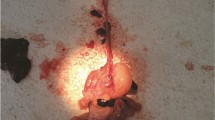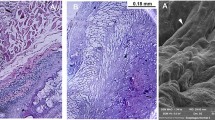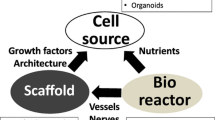Abstract
Recently, tissue engineering of the autologous esophagus has been thought to provide a promising strategy for esophageal substitution. In this study, gastric acellular matrix (GAM) was used as a scaffold for regeneration of the esophagus in a rat model. Usage of GAM has an advantage that naturally derived extracellular matrix autograft can be prepared less invasively in a clinical setting. Twenty-seven F344 female rats were used as recipients. Patch defects created in the abdominal esophagus were replaced by GAM patch grafts. The rats were sacrificed 1 week to 18 months after implantation. The specimen was examined macroscopically as well as microscopically. 5′-Bromo-2′-deoxyuridine (BrdU) proliferation assay was performed in six rats that were sacrificed 1, 2, and 4 weeks after implantation. Twenty-four rats survived without complications. The graft site did not show esophageal stenosis or dilatation in any rat. Keratinized stratified squamous esophageal mucosa was regenerated in the entire graft 2 weeks after implantation. Regeneration of the muscle layer or lamina muscularis mucosae in the graft site was not observed even 18 months after implantation. Marked incorporation of BrdU was observed only in the mucosal layer but not in the muscle layer. GAM patch graft provided satisfactory mucosal regeneration of the esophagus without stenosis or dilatation, although muscle regeneration was still a future challenge.
Similar content being viewed by others
Avoid common mistakes on your manuscript.
Introduction
Esophageal substitution is required in several conditions such as esophageal atresia, acquired constriction esophagitis, and esophagotomy. Gastrointestinal segments including stomach, small intestine and colon are often used in esophageal substitution. These procedures consisting of laparotomy for resection of gastrointestinal segments and esophageal reconstruction are highly invasive. These segments do not function as well as the esophagus in providing an efficient conduit. When stomach tissue is used, the gastric mucosa produces gastric juice, which damages the esophageal mucosa. Furthermore, there is a possibility that these substituted segments will develop cancer in the future. Recently tissue engineering of the esophagus has been considered a promising alternative strategy for esophageal substitution. Success in regeneration of the esophagus is the first important step to regenerate other gastrointestinal tracts because the esophagus is a simple model of gastrointestinal tracts anatomically as well as physiologically.
Several scaffolds have been used for construction of tissue-engineered esophagus. Naturally derived extracellular matrices such as small intestinal submucosa (SIS) and urinary bladder acellular matrix (BAM), collagen and biodegradable synthetic polymers such as poly-glycolic acid (PGA) and poly(d,l-lactic-co-glycolic acid) (PLGA) have been shown to have good potential to regenerate the esophagus [1–5]. Here we investigated the use of gastric acellular matrix (GAM) to replace the esophageal defect in a rat model. GAM is a naturally derived extracellular matrix like BAM and can be less invasively prepared than BAM as an autograft in a clinical setting. GAM has also been used for bladder augmentation and intestinal substitution in animal experiments, and demonstrated promising results [6, 7].
Materials and methods
Preparation of GAM
Gastric acellular matrix was prepared as previously described [6, 7]. Briefly, whole stomachs obtained from female F344 rats were opened, then rinsed in phosphate buffered saline (PBS) solution. The stomachs were placed in distilled water and agitated using a magnetic bar for 72 h at 4°C. Then the stomachs were suspended and stirred for 8 h in 4% sodium deoxycholate. Specimens were washed with PBS, then stirred for 12 h in 1 mol/l NaCl containing 2,000 K units of deoxyribonuclease I. These procedures were repeated three times. The absence of cellular elements was confirmed by hematoxylin and eosin (H&E) staining and the acellular matrices were refrigerated in 0.9% PBS containing penicillin-streptomycin mixture until use.
Surgical procedures
Twenty-seven female F344 rats of inbred strain (age 9–16 weeks; weight 134–180 g) were used as recipients. Under ether anesthesia, rats underwent upper midline abdominal laparotomy. The abdominal esophagus was mobilized. A semicircular defect measuring approximately 3–4 mm in width and 5 mm in length was created in the abdominal esophagus 5 mm proximal to the cardia and was replaced by GAM using interrupted sutures of 7–0 silk (Fig. 1). The GAM patch was then covered with omentum. The abdomen was closed after gentamicin (0.1 mg) was given intraperitoneally. Postoperatively, the rats were returned to the cage and allowed unrestricted oral and water intake but did not receive any antibiotics.
Evaluation of the GAM graft
Every two rats were sacrificed at various times (1, 2, 4 weeks, and 2, 4, 6, 8, 12, 18 months) after operation. The abdominal esophagus including the graft was removed and examined macroscopically as well as microscopically. Paraffin-embedded sections were stained with H&E and with Masson’s Trichrome (MT). Immunostaining of paraffin-embedded section was performed using mouse-derived anti-desmin monoclonal antibodies (1:100, DAKO, Kyoto, Japan) and mouse-derived anti-α-smooth muscle actin monoclonal antibodies (1:50, DAKO, Kyoto, Japan). The DAKO envision + detection system using dextran polymers conjugated with horseradish peroxidase (DAKO, Kyoto, Japan) was employed for detection. The slides were counter-stained with hematoxylin.
In additional six rats, 5′-bromo-2′-deoxyuridine (BrdU) proliferation assay using the Cell Proliferation Kit (Amersham Biosciences, UK) was performed. BrdU was injected intraperitoneally 2 h before every two of the animals were sacrificed 1, 2, and 4 weeks after implantation, respectively. BrdU incorporation in frozen sections was detected according to the manufacturer’s instructions. The slides were counterstained by eosin.
These animal experiments were consistent with the University of Tsukuba’s Regulation of Animal Experiments and the protocol was approved by the Animal Experiment Committee, University of Tsukuba (#29).
Results
Macroscopic examination
One rat died within 1 week because of anastomotic leakage. Paraesophageal cyst formation resulting from minor anastomotic leakage was observed in two rats that were sacrificed 4 and 8 weeks after implantation, respectively. The other 24 rats survived without anastomotic leakage. Macroscopically, the esophagus did not show stenosis or dilatation in any rat. Mucosal regeneration was completed in the entire GAM patch graft 2 weeks after placement. Macroscopically, the inner surface of the patch could not be distinguished from native mucosa after the suture materials were removed (Figs. 2, 3a). Gross appearance of the longitudinal section stained with MT demonstrated regeneration of esophageal mucosa with underlying amuscular connective tissue (Fig. 3b). The muscle layer proximal to the graft site showed hypetrophic changes (Fig. 3b).
Photographs of the esophagus 18 months after implantation. a The mucosal surface showed almost normal appearance without stenosis or dilatation. The longitudinally sectioned line was shown by a dotted line. b Gross appearance of the longitudinal section stained by Masson-Trichrome demonstrated the regenerated mucosa with underlying amuscular connective tissue (5 mm in length, shown by an arrow) and hypertrophied muscle layer proximal to the graft site (shown by arrowheads). m muscle layer
Microscopic examination
The entire patch graft was covered by keratinized stratified squamous cells 2 weeks after implantation (Figs. 2a, 4a), while the patch graft was partially covered after 1 week. Infiltration of inflammatory mononuclear cells into the GAM graft and polymorphonuclear cells around the suture materials was prominent until 2 months after implantation (Fig. 4a). Inflammation subsided by 4 months and thereafter, non-inflammatory connective tissue containing fibroblasts and blood vessels was observed under the neomucosa (Fig. 4b).
a Esophageal mucosal regeneration in the GAM patch graft 2 weeks after implantation, showing the presence of marked inflammatory cells and absence of muscle tissue under the neomucosa (H&E staining, ×40). b Remodeling tissue under the neomucosa in the graft 4 months after implantation, showing non-inflammatory connective tissue containing fibroblasts and blood vessels without regeneration of neomuscle (MT staining, ×40)
Immunohistochemical staining for desmin did not show regeneration of the esophageal muscle layer at the graft site even 18 months after implantation. The margins of the native esophageal muscle layer could be observed around the defect, and there were no muscle cells under the regenerated mucosa. There was no lamina muscularis mucosae detected by α-smooth muscle actin and desmin antibodies under the regenerated mucosa at the graft site either.
Numerous cells incorporating the proliferation marker BrdU were found at the bottom of native as well as regenerated mucosal layer (Fig. 5a). In contrast, only scattered BrdU-positive cells were observed at the margin of the native muscle layer (Fig. 5b).
BrdU proliferation assay in the graft site after implantation. a Numerous BrdU-positive cells were located at the bottom of the neomucosa (indicated by arrowheads) 1 week after implantation (×100). b Only a few BrdU-positive cells were found in the marginal region of the native muscle (shown by arrows) 4 weeks after implantation (×100)
Discussion
Recently successful replacement of the esophageal defect by tissue-engineered esophagus has been considered a promising strategy. These procedures can be performed by less invasive surgery. Many attempts have been applied to esophageal regeneration using ex vivo as well as in situ tissue engineering [1–5]. The scaffolds good for esophageal regeneration are an important factor. Naturally derived extracellular matrices such as porcine-derived SIS and BAM, naturally derived polymers such as collagen, and synthetic polymers including PLGA have been used for in situ tissue engineering of the esophagus [1–3]. It is known that naturally derived acellular matrices such as SIS and BAM promote cell migration, cell adherence, and tissue organization in vivo [8]. These characteristics would be advantageous in in situ tissue engineering, during which repopulation of scaffolds by functional cells is essential. To date, BAM has been used for urinary bladder replacement in animal experiments. A number of reports have shown its usefulness [7–9]. In esophageal regeneration, it is difficult to use BAM as an autograft considering the damages to urinary bladder. SIS is also a useful scaffold, which is effective in regeneration of a variety of tissues including urinary bladder, blood vessels, abdominal wall, tendon, and bone [8]. SIS is a commercially available porcine-derived material, but it is xenogenic when used in humans. Accordingly, ethical problems as well as the potential for unknown infections have yet to be solved. In this study, we applied GAM to in situ tissue engineering of the esophagus. GAM is a naturally derived scaffold, which is expected to promote tissue regeneration like SIS and BAM. GAM as well as BAM prepared by the same procedure is expected to preserve the basement membrane even after removal of cells, which preserves the characteristics of selective permeability [6, 10]. GAM can be prepared as an autograft in a clinical setting using a less invasive technique, since sacrificing the portion of stomach used for GAM is minimal. Autograft is ideal as an implanted scaffold, because allograft presents many problems to be solved such as rejection, unknown infections and ethics. GAM is devoid of acid-producing gastric mucosal glands. GAM has been used for in situ tissue engineering of urinary bladder and small intestine, and has shown promising results [6, 7]. When the esophagus is regenerated using GAM, it would be expected to grow with the child. Considering these, GAM is thought to be one of the ideal scaffolds for esophageal regeneration.
Regeneration of the esophagus using GAM was examined in a rat model of inbred strain. Female to female transplantation of syngenic grafts (isografts) used in this study was considered to develop no rejection as well as that of autografts. GAM patch grafts were implanted in the abdominal esophagus of rats. First, we implanted tubularized GAM for circumferential segmental defects. However, the rats died from packing their own hairs in the graft site with subsequent dilatation; these hairs were swallowed when the animals were not given any food after surgery. Therefore, GAM patch grafts equivalent to around one-third of the circumference were used instead. In GAM patch grafts, esophageal mucosal regeneration was found to be excellent. Early prominent cell proliferation at the bottom of the neomucosa was confirmed by BrdU assay (Fig. 5a). Two weeks after implantation, regeneration of keratinized stratified squamous mucosa was completed. Macroscopically, stenosis or dilatation was not observed in any rat (Figs. 2, 3a). It was very difficult to measure the final size of the grafts exactly in many of the specimen because the inner surface of the patch could not be distinguished from native mucosa and the outer surface showed strong adhesions of the wrapped omentum. The final length of the neomucosa in the longitudinal section 18 months after implantation was 5 mm (Fig. 3b). In contrast, there was no ingrowth of the inner or outer muscle layer detected by desmin at the graft site even on observation after 18 months (Fig. 3b). Immunohistochemical study showed that the lamina muscularis mucosae were not regenerated at the graft site either. Several reports on animal experiments involving in situ tissue engineering of the esophagus have shown regeneration or ingrowth of muscle layer or muscle cells [1–3]. Although the presence of muscle-like cells or myofibroblasts positive for muscle-specific antigen has been shown, a massive volume of regenerated muscle tissue has never been observed. In this study, proliferation assay using BrdU showed that there was no increased incorporation of the proliferation marker BrdU at the margins of the native muscle layer during esophageal regeneration using GAM (Fig. 5b). The number of BrdU positive cells there was the same as that in the intact muscle. Our study suggested that muscle regeneration was unlikely to occur so easily. In experimental animals including rats, rabbits, dogs, and pigs, the muscle layer of the esophagus consisted of skeletal muscle. Skeletal muscle cells require nerve stimulation to survive. Complete muscle regeneration must be accompanied not only by blood supply but also by nerve stimulation, which cannot be completed so easily. However, it is not clear whether the muscle layer is essential for the esophagus to function. Probably a small amuscular portion of the esophagus would not influence esophageal function as long as the area shows some mechanical strength. Circular myotomy has been conducted in patients with esophageal atresia to elongate the esophagus before anastomosis. Some patients with such an amuscular portion of the esophagus due to this method have not shown any problem postoperatively, although others have been complicated by ballooning. Our previous data also demonstrated that prevention of ballooning after myectomy by application of a collagen sponge scaffold provided a good postoperative course in growing piglets [11]. Therefore, esophageal regeneration using GAM may provide a useful tool for bridging the proximal and distal end in esophageal atresia showing a long gap.
Conclusion
Gastric acellular matrix was considered a valuable scaffold for tissue engineering of the esophagus. The advantage of GAM over other scaffolds is that it can be prepared less invasively as a naturally derived autograft in clinical application. GAM patch graft provided satisfactory results for esophageal mucosal regeneration without stenosis or dilatation, although application of tubularized grafts to a bigger animal model has to be evaluated next. Our data also suggest that regeneration of the muscle layer is a future challenge. A new breakthrough for muscle regeneration accompanied by nerve regrowth and neovascularization including application of stem cells and growth factors may be required.
References
Takimoto Y, Nakamura T, Yamamoto Y, Kiyotani T, Teramachi M, Shimizu Y (1998) The experimental replacement of a cervical esophageal segment with an artificial prosthesis with the use of collagen matrix and a silicone stent. J Thorac Cardiovasc Surg 116:98–106
Badylak S, Meurling S, Chen M, Spievack A, Simmons-Byrd A (2000) Resorbable bioscaffold for esophageal repair in a dog model. J Pediatr Surg 35:1097–1103
Lynen Jansen P, Klinge U, Anurov M, Titkova S, Mertens PR, Jansen M (2004) Surgical mesh as a scaffold for tissue regeneration in the esophagus. Eur Surg Res 36:104–111
Miki H, Ando N, Ozawa S, Sato M, Hayashi K, Kitajima M (1999) An artificial esophagus constructed of cultured human esophageal epithelial cells, fibroblasts, polyglycolic acid mesh, and collagen. ASAIO J 45:502–508
Grikscheit T, Ochoa ER, Srinivasan A, Gaissert H, Vacanti JP (2003) Tissue-engineered esophagus: experimental substitution by onlay patch or interposition. J Thorac Cardiovasc Surg 126:537–544
Parnigotto PP, Marzaro M, Artusi T, Perrino G, Conconi MT (2000) Short bowel syndrome: experimental approach to increase intestinal surface in rats by gastric homologous acellular matrix. J Pediatr Surg 35:1304–1308
Sutherland RS, Baskin LS, Hayward SW, Cunha GR (1996) Regeneration of bladder urothelium, smooth muscle, blood vessels and nerves into an acellular tissue matrix. J Urol 156:571–577
Hodde J (2000) Naturally occurring scaffolds for soft tissue repair and regeneration. Tissue Eng 8:295–308
Piechota HJ, Dahms SE, Nunes LS, Dahiya R, Lue TF, Tanagho EA (1998) In vitro functional properties of the rat bladder regenerated by the bladder acellular matrix graft. J Urol 159:1717–1724
Meezan E, Hjelle JT, Brendel K (1975) A simple, versatile, nondisruptive method for the isolation of morphologically and chemically pure basement membranes from several tissues. Life Sci 17:1721–1732
Komuro H, Nakamura T, Kaneko M, Nakanishi Y, Shimizu Y (2002) Application of collagen sponge scaffold to muscular defects of the esophagus: an experimental study in piglets. J Pediatr Surg 37:1409–1413
Acknowledgments
The authors thank Natsuko Kato for technical assistance. This work was supported by grant-in-aids for scientific research (no. 17390472) from the Japan Society for the Promotion of Science.
Author information
Authors and Affiliations
Corresponding author
Rights and permissions
About this article
Cite this article
Urita, Y., Komuro, H., Chen, G. et al. Regeneration of the esophagus using gastric acellular matrix: an experimental study in a rat model. Pediatr Surg Int 23, 21–26 (2007). https://doi.org/10.1007/s00383-006-1799-0
Published:
Issue Date:
DOI: https://doi.org/10.1007/s00383-006-1799-0









